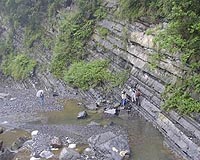 |
Stony Brook NY (SPX) Jul 29, 2009 Temperature explains much of why cold-blooded organisms such as fish, amphibians, crustaceans, and lizards live longer at higher latitudes than at lower latitudes, according to research published this week in the Proceedings of the National Academy of Sciences (PNAS) online. Assistant Professor Dr. Stephan Munch and Ph.D. candidate Santiago Salinas, both of Stony Brook University's School of Marine and Atmospheric Sciences (SoMAS), found that for a diverse range of species whose body temperatures vary with the temperature of their surroundings, ambient temperature is the dominant factor controlling geographic variation of lifespan within species. "We were intrigued by the fact that that pearl mussels in Spain have a maximum lifespan of 29 years, while in Russia, individuals of the same species live nearly 200 years," said Dr. Munch. "We wondered how a relatively small difference in latitude (Spain 43 degrees N and Russia 66 degrees N) could have such a drastic impact on lifespan. While one might expect that local adaptations or geographic variations in predator and food abundance would account for this disparity, we wanted to see whether the geographical variation in lifespan that we see in all sorts of species has a common physiological basis in temperature." Munch and Salinas looked at lifespan data from laboratory and field observations for over 90 species from terrestrial, freshwater, and marine environments. They studied organisms with different average longevities--from the copepod Arcartia tonsa, which has an average lifespan of 11.6 days, to the pearl mussel Margaritifera margaritifera, which has an average lifespan of 74 years. They found that across this wide range of species, temperature was consistently exponentially related to lifespan. The relationship between temperature and lifespan that Munch and Salinas found through data analysis was strikingly similar to the relationship that the metabolic theory of ecology (MTE) predicts. The MTE is a modeling framework that has been used to explain the way in which life history, population dynamics, geographic patterns, and other ecological processes scale with an animal's body size and temperature. "You can think of an animal as a beaker in which chemical reactions are taking place," said Salinas. "The same rules that apply to a liquid inside a beaker should apply to animals. Chemists have a relationship for how an increase in temperature will speed up reaction rates, so the MTE borrows that relationship and applies it--with some obvious caveats--to living things." The lifespan in 87% of the free-living species Munch and Salinas studied varied as predicted by the MTE. Yet after removing the effect of temperature, there was still considerable variation in lifespan within species, indicating that other, local factors still play a role in determining lifespan. "It is interesting to consider how cold-blooded species are likely to react in the face of global warming," said Salinas. "Because of the exponential relationship between temperature and lifespan, small changes in temperature could result in relatively large changes in lifespan. We could see changes to ecosystem structure and stability if cold-blooded species change their life histories to accommodate warmer temperatures but warm-blooded species do not." Share This Article With Planet Earth
Related Links Stony Brook University Darwin Today At TerraDaily.com
 Earliest Animals Lived In A Lake Environment
Earliest Animals Lived In A Lake EnvironmentRiverside CA (SPX) Jul 29, 2009 Evidence for life on Earth stretches back billions of years, with simple single-celled organisms like bacteria dominating the record. When multi-celled animal life appeared on the planet after 3 billion years of single cell organisms, animals diversified rapidly. Conventional wisdom has it that animal evolution began in the ocean, with animal life adapting much later in Earth history to ... read more |
|
| The content herein, unless otherwise known to be public domain, are Copyright 1995-2009 - SpaceDaily. AFP and UPI Wire Stories are copyright Agence France-Presse and United Press International. ESA Portal Reports are copyright European Space Agency. All NASA sourced material is public domain. Additional copyrights may apply in whole or part to other bona fide parties. Advertising does not imply endorsement,agreement or approval of any opinions, statements or information provided by SpaceDaily on any Web page published or hosted by SpaceDaily. Privacy Statement |